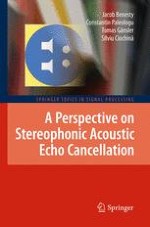
2011 | OriginalPaper | Chapter
Introduction
Authors : Jacob Benesty, Constantin Paleologu, Tomas Gänsler, Silviu Ciochină
Published in: A Perspective on Stereophonic Acoustic Echo Cancellation
Publisher: Springer Berlin Heidelberg
Activate our intelligent search to find suitable subject content or patents.
Select sections of text to find matching patents with Artificial Intelligence. powered by
Select sections of text to find additional relevant content using AI-assisted search. powered by
Research and development of stereophonic echo control systems has been a subject of interest over the last 20+ years. In fact, one of the first papers describing the characteristics of stereophonic echo cancellation was presented in 1991 [1]. In this paper, it is pointed out that the loudspeaker (input) signals are linearly related through non-invertible acoustic room responses (in the case of one source, but not necessarily two or more). The consequence of this linear relationship is that the underlying normal (or Wiener-Hopf) equations to be solved by the adaptive algorithm is an ill-conditioned, or in the worst case, a singular problem. In the singular case, the adaptive filter can drift between candidates in the set of available nonunique solutions, all minimizing the variance of the output error. However, these solutions do not necessarily minimize filter misalignment. As a result, some unstable behavior for certain time varying events may be expected. Even though the problem of nonuniqueness was described, analyzed, and solutions presented in early publications, e.g., [2], [3], [4], many following proposals have been confused over what has to be done to solve the problem correctly. Fundamentally, the core solution to the stereophonic acoustic echo cancellation (SAEC) problem must tackle two issues: (a) provide a proper solution to the inherent ill-posed problem of stereophonic echo cancellation and (b) mitigate the effect that the ill-posed problem has on the convergence rate and tracking of the adaptive algorithm. The former problem (a), can only be solved by manipulating the signals actually transmitted to the near-end (receiving) room, i.e., using a preprocessor on the loudspeaker signals to decorrelate them (or more accurately to reduce the coherence) before the SAEC as well as before transmitting them to the far-end room.